Home / Initiation, Propagation, Termination
Free Radical Reactions
Initiation, Propagation, Termination
Last updated: July 8th, 2025 |
Initiation, Propagation, and Termination In Free Radical Reactions
In the previous post on free radical substitution reactions we talked about why heat or light is required in free-radical reactions (See post: Free Radical Reactions – Why Is Heat or Light Required). In this post we’re going to go through the mechanism of a free-radical substitution reaction, which has three key types of steps: initiation, propagation, and termination.
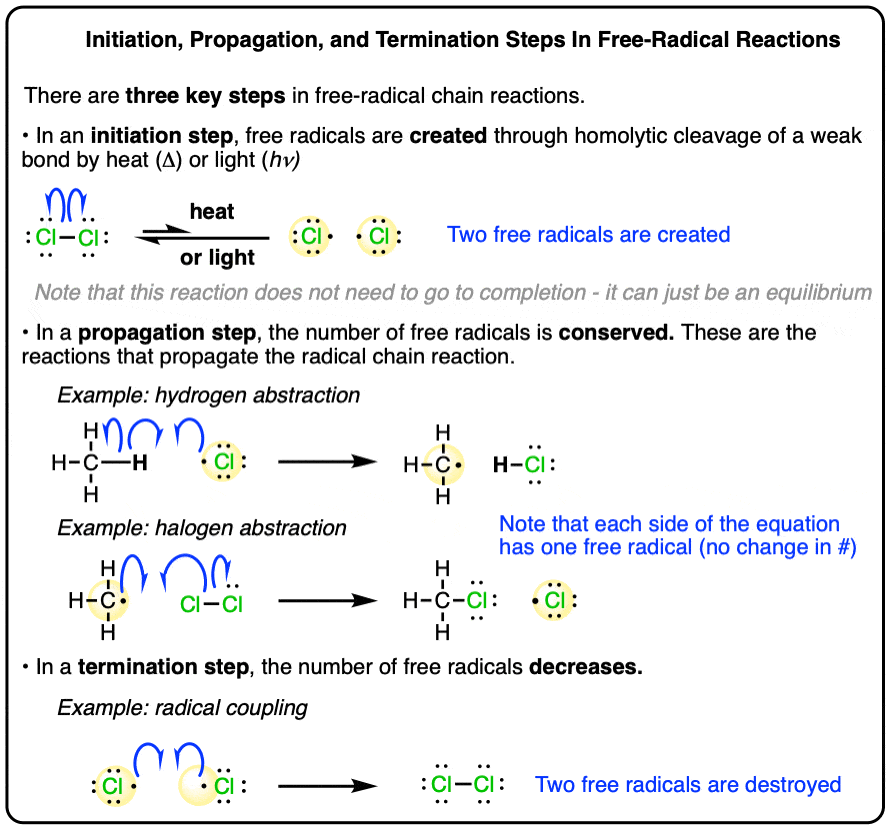
Table of Contents
- The Mechanism For The Free-Radical Substitution Of An Alkane With Cl2
- A Step Where There Is A Net Increase In The Number of Free Radicals Is Called “Initiation”
- A Step Where There Is No Net Gain Or Loss Of Free Radicals Is Called “Propagation”
- Watch Out For This Common Mistake In Drawing Out Free-Radical Mechanisms
- There Are Two Propagation Steps In Free Radical Halogenation Of Alkanes
- A Step Where There Is A Net Decrease In Free Radicals Is Called, “Termination”
- The Full Mechanism Of Free-Radical Substitution Of An Alkane
- Summary: Free-Radical Substitution Reactions
- Notes
- Quiz Yourself!
- (Advanced) References and Further Reading
1. The Mechanism For The Free-Radical Substitution Of An Alkane With Cl2
You may recall seeing this reaction in a previous post – it’s the free radical chlorination of methane with Cl2.
It’s a substitution on carbon because a C-H bond breaks and a new C-Cl bond forms on the same carbon. The byproduct is HCl.

Now that we know a little more about what free radicals are and their key properties, today we will answer, “how does this reaction work?“.
We’re going to go through the key steps of this reaction and learn that they are composed of three key phases: initiation, termination, and propagation.
2. A Step Where There Is a Net Increase In The Number Of Free Radicals Is Called, “Initiation”
Free-radical reactions generally require heat or light to be applied. That’s because either of these energy sources can lead to homolytic cleavage of relatively weak bonds like Cl-Cl to give free radicals [i.e. Cl• ]
Every free radical reaction begins with a step where free radicals are created, and for that reason this initial step is called initiation.
Here’s the equation for this initiation step. Two things to note:
- The reaction is an equilibrium – at any given time there is only a small concentration of the free radical present (but this will be enough, as we shall see)
- Note that there is a net increase of free radicals in this reaction. We’re going from zero (in the reactants) to two (in the products).

3. A Step Where There Is No Net Gain Or Loss Of Free Radicals Is Called “Propagation”
It’s only once the free radicals are present that our substrate (CH4 in our example) gets involved. Chlorine radicals are highly reactive, and can combine with a hydrogen from methane to give the methyl radical, •CH3
If you count the number of free radicals in this equation, you’ll note that there’s one in the reactants and one in the products. So there is no net increase in the number of free radicals.
This type of step is referred to as “propagation”.

If you’re keeping score, by this point you should be able to see that there’s only one bond left to form before our reaction is complete. All we need to do is to form a C–Cl bond.
4. Watch Out For This Common Mistake In Drawing Out Free-Radical Mechanisms
It’s here where it’s easy to make a little mistake. Seeing that there’s two chlorine radicals formed in the initiation step, it would seem natural to bring together the methyl radical and the chlorine radical to form CH3–Cl . Right?????
Nooooo!
Note the number of free radicals has decreased here, not stayed the same. It can’t be propagation! (It’s actually termination, which we’ll discuss in a minute).

5. There Are Two Propagation Steps In Free-Radical Substitution
In fact, we can do the proper “propagation” step this way: Take the methyl radical, and it reacts with the Cl2 still present. This gives us CH3Cl and the chlorine radical. Note that there has been no net change in the number of free radicals, so this is still a “propagation”.

Note again that we are forming a chlorine radical! What’s so crucial about this? It’s crucial because this chlorine radical can then perform Propagation Step #1 on a new molecule of our substrate (CH4), continuing the process. It’s a chain reaction – once generated, chlorine radical is catalytic. That’s why we only need a small amount of chlorine radical for this reaction to proceed. It is not unusual for 104 or more of these cycles to proceed before termination occurs. (See this reference below)
6. A Step Where There Is A Net Decrease In Free Radicals Is Called, “Termination”
Can this chain reaction go on forever? No.
Let’s think about two limiting cases. If the concentration of Cl2 is low relative to CH4 (in other words, Cl2 is our limiting reagent) then the rate of Propagation Step #2 will slow down as its concentration decreases. Without any Cl2 to react with, our •CH3 radicals can just combine with another free radical (such as •Cl) to give CH3Cl, for example. There is essentially no barrier to this reaction. Note that here the number of free radicals decreases from 2 to zero. This is called termination.

It’s also possible for two methyl groups to combine together to give CH3–CH3 ; this is also termination!
7. The Full Mechanism Of Free-Radical Substitution Of An Alkane
Let’s put all of these steps together so we can clearly see the initiation, propagation, and termination steps.

8. Summary: Free-Radical Substitution Reactions
These three types of steps are encountered in every free-radical reaction.
The bottom line here is that by counting the number of radicals created or destroyed in each step, you can determine if the step is initiation, propagation, or termination.
- Intiation -> net formation of radicals
- Propagation -> no change in the number of free radicals
- Termination -> net destruction of free radicals
We’ll leave with two teasers for future posts.
First… note that here we’re using CH4, where every C–H bond is identical. What might happen if we used an alkane where all the C–H bonds aren’t equal… like propane, or pentane, for example?
Secondly, this reaction fails spectacularly when Br2 is used instead of Cl2 for the reaction of CH4. However, we’ll see that Br2 can work in certain special cases.
More soon!
Next Post: Isomers From Free Radical Reactions
Notes
Related Articles
- Monochlorination Products Of Propane, Pentane, And Other Alkanes
- Selectivity in Free Radical Reactions: Bromination vs. Chlorination
- Free Radical Initiation: Why Is “Light” Or “Heat” Required?
- Bond Dissociation Energies = Homolytic Cleavage
- In Summary: Free Radicals
- Free Radicals Practice Quizzes (MOC Membership required)
Using Cl2 in excess
We just talked about the situation where one equivalent of chlorine (Cl2) is used. What happens when we use multiple equivalents, or even a vast excess?
Think about it for a second. Imagine we had multiple equivalents of Cl2 in the presence of CH3Cl. What do you think might happen?
An atom of Cl• could react with CH3Cl to give •CH2Cl [and HCl], which could then react with Cl2 to give CH2Cl2 !

Likewise, if we still have an excess of Cl2, then we will observe conversion of CH2Cl2 to CHCl3.

Finally, given enough Cl2 we could then imagine the conversion of CHCl3 to give CCl4.

At this point there are no further C-H bonds to react with the chlorine radical, and thus our reaction would eventually terminate.
The bottom line here is that alkanes, given a large enough excess of Cl2, will eventually have all of their hydrogens replaced with chlorine.
This pathway is in fact how dichloromethane (CH2Cl2 – a common laboratory solvent) chloroform (CHCl3) and carbon tetrachloride (CCl4) are produced industrially. For many decades, CCl4 was produced on mega-ton scale for use as a refrigerant and dry cleaning solvent until studies implicated it and other CFC’s in depletion of the ozone layer.
Quiz Yourself!
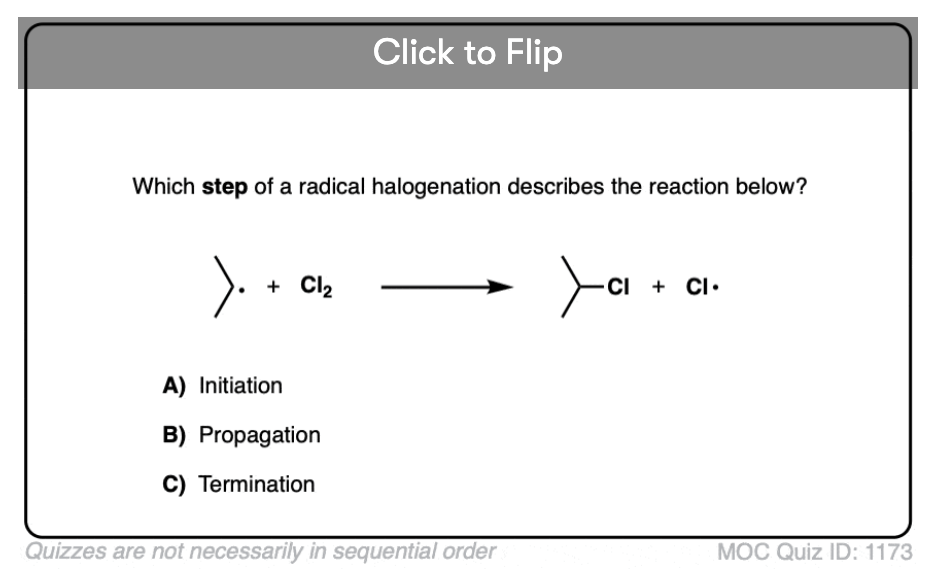
Become a MOC member to see the clickable quiz with answers on the back.
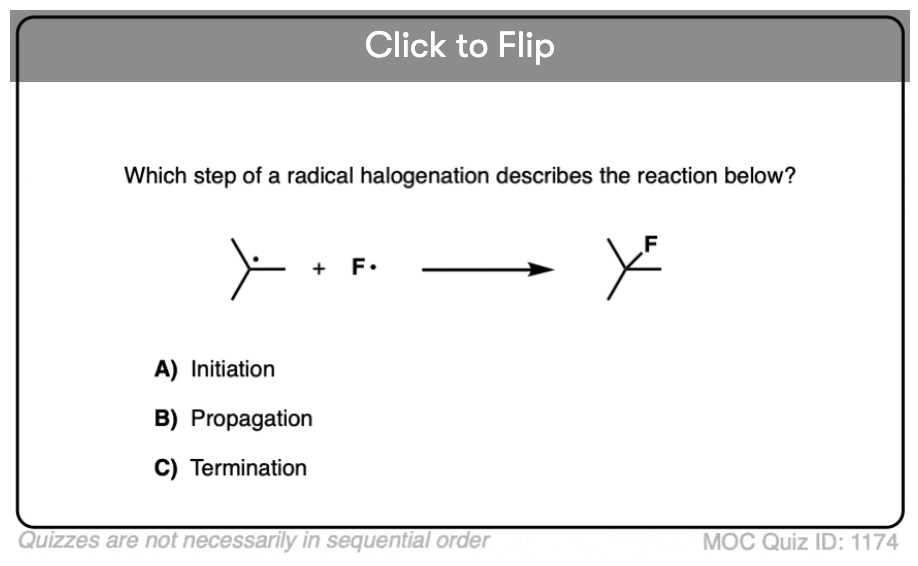
Become a MOC member to see the clickable quiz with answers on the back.
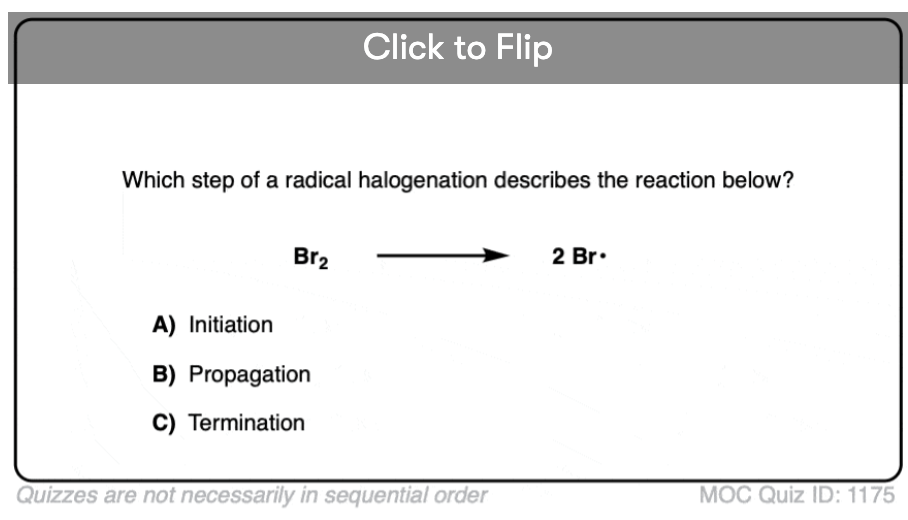
Become a MOC member to see the clickable quiz with answers on the back.

Become a MOC member to see the clickable quiz with answers on the back.
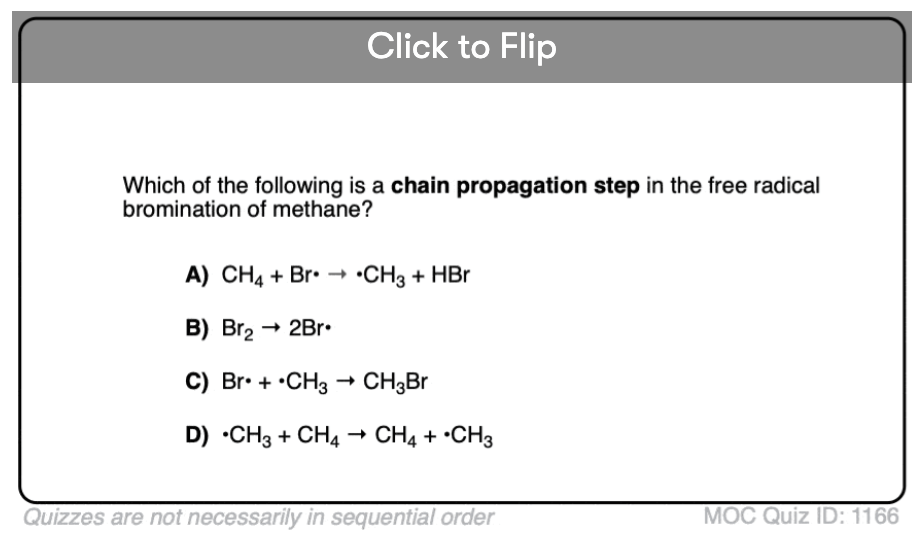
Become a MOC member to see the clickable quiz with answers on the back.
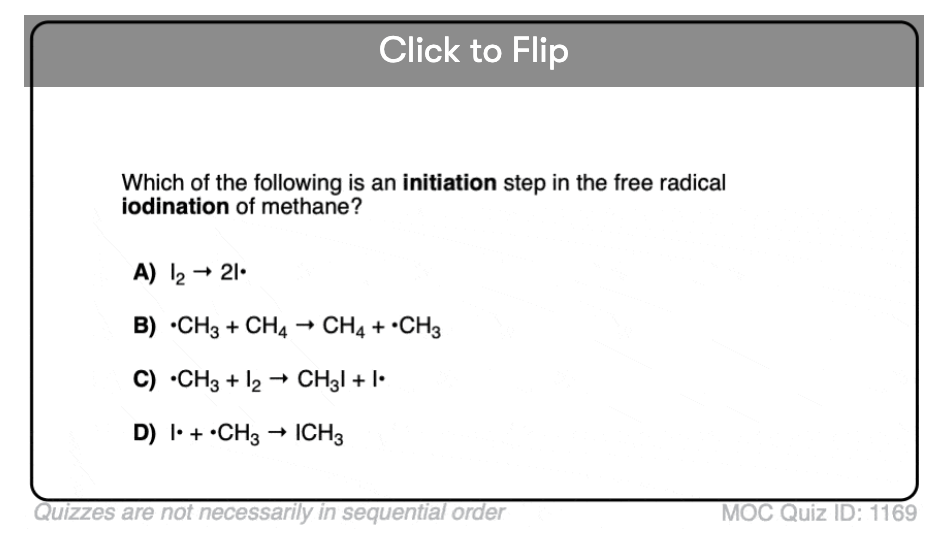
Become a MOC member to see the clickable quiz with answers on the back.
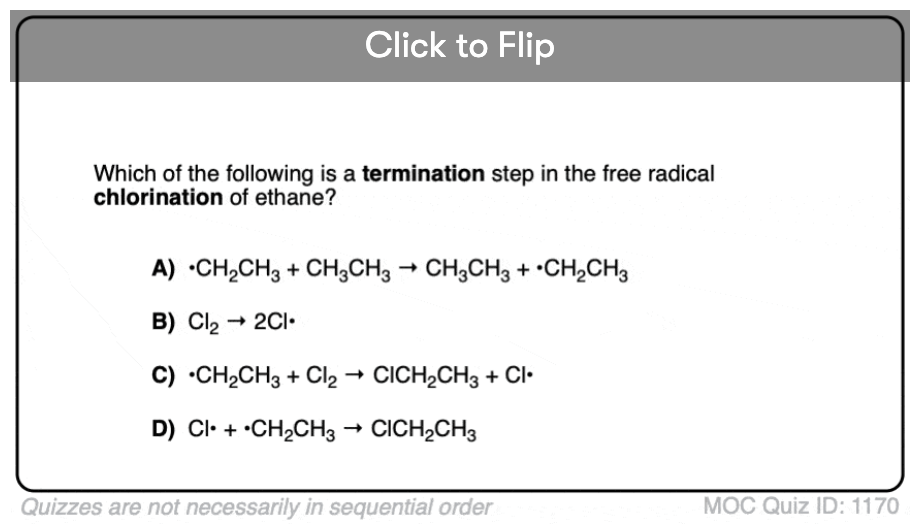
Become a MOC member to see the clickable quiz with answers on the back.
(Advanced) References and Further Reading
- Walling, C. in Free Radicals In Solution, Wiley and Sons, New York 1957 p. 352
- Chlorination of Methane
T. McBee, H. B. Hass, C. M. Neher, and H. Strickland
Industrial & Engineering Chemistry 1942, 34 (3), 296-300
DOI: 10.1021/ie50387a009
This paper shows that the chlorination of methane can be controlled to give any of the desired chloromethanes in high yield. This is of significance because CH3Cl, CH2Cl2, CHCl3, and CCl4 are all important feedstocks or solvents and this is how they are produced industrially. - KINETICS OF THE THERMAL CHLORINATION OF METHANE
Robert N. Pease and George F. Walz
Journal of the American Chemical Society 1931, 53 (10), 3728-3737
DOI: 10.1021/ja01361a016
This paper provides kinetic evidence that chlorination of methane is 2nd order (first order in both methane and Cl2). - THE BROMINATION OF CYCLOHEXANE, METHYLCYCLOHEXANE, AND ISOBUTANE
M. S. KHARASCH, WILLIAM HERED, and FRANK R. MAYO
The Journal of Organic Chemistry 1941 06 (6), 818-829
DOI: 10.1021/jo01206a005
The nature of the free-radical chain reaction mechanism in the substitution of alkanes was not fully worked out until the 1940s. In this pioneering 1941 report, Kharasch proposes the chain mechanism we now read in textbooks:
a) Br2 + hv –> 2 Br • (initiation)
b) R–H + Br• –> R• + HBr (propagation step 1)
c) R• + Br2 –> R-Br + Br• (propagation step 2)
Kharasch reports that free-radical substitution of cyclohexane with Br2 reacts very slowly in the dark, or in the absence of oxygen. In low concentration, oxygen can act as a free-radical initiator (forming Br• radicals from Br2) but here Kharasch also observes that in high concentration oxygen can inhibit free-radical reactions. The selectivity of Br• to react with C-H bonds in the order tertiary > secondary > primary is also noted.
00 General Chemistry Review
01 Bonding, Structure, and Resonance
- How Do We Know Methane (CH4) Is Tetrahedral?
- Hybrid Orbitals and Hybridization
- How To Determine Hybridization: A Shortcut
- Orbital Hybridization And Bond Strengths
- Sigma bonds come in six varieties: Pi bonds come in one
- Dipole Moments and Dipoles
- A Key Skill: How to Calculate Formal Charge
- The Four Intermolecular Forces and How They Affect Boiling Points
- 3 Trends That Affect Boiling Points
- How To Use Electronegativity To Determine Electron Density (and why NOT to trust formal charge)
- Introduction to Resonance
- How To Use Curved Arrows To Interchange Resonance Forms
- Evaluating Resonance Forms (1) - The Rule of Least Charges
- How To Find The Best Resonance Structure By Applying Electronegativity
- Evaluating Resonance Structures With Negative Charges
- Evaluating Resonance Structures With Positive Charge
- Exploring Resonance: Pi-Donation
- Exploring Resonance: Pi-acceptors
- In Summary: Evaluating Resonance Structures
- Drawing Resonance Structures: 3 Common Mistakes To Avoid
- How to apply electronegativity and resonance to understand reactivity
- Bond Hybridization Practice
- Structure and Bonding Practice Quizzes
- Resonance Structures Practice
02 Acid Base Reactions
- Introduction to Acid-Base Reactions
- Acid Base Reactions In Organic Chemistry
- The Stronger The Acid, The Weaker The Conjugate Base
- Walkthrough of Acid-Base Reactions (3) - Acidity Trends
- Five Key Factors That Influence Acidity
- Acid-Base Reactions: Introducing Ka and pKa
- How to Use a pKa Table
- The pKa Table Is Your Friend
- A Handy Rule of Thumb for Acid-Base Reactions
- Acid Base Reactions Are Fast
- pKa Values Span 60 Orders Of Magnitude
- How Protonation and Deprotonation Affect Reactivity
- Acid Base Practice Problems
03 Alkanes and Nomenclature
- Meet the (Most Important) Functional Groups
- Condensed Formulas: Deciphering What the Brackets Mean
- Hidden Hydrogens, Hidden Lone Pairs, Hidden Counterions
- Don't Be Futyl, Learn The Butyls
- Primary, Secondary, Tertiary, Quaternary In Organic Chemistry
- Branching, and Its Affect On Melting and Boiling Points
- The Many, Many Ways of Drawing Butane
- Wedge And Dash Convention For Tetrahedral Carbon
- Common Mistakes in Organic Chemistry: Pentavalent Carbon
- Table of Functional Group Priorities for Nomenclature
- Summary Sheet - Alkane Nomenclature
- Organic Chemistry IUPAC Nomenclature Demystified With A Simple Puzzle Piece Approach
- Boiling Point Quizzes
- Organic Chemistry Nomenclature Quizzes
04 Conformations and Cycloalkanes
- Staggered vs Eclipsed Conformations of Ethane
- Conformational Isomers of Propane
- Newman Projection of Butane (and Gauche Conformation)
- Introduction to Cycloalkanes
- Geometric Isomers In Small Rings: Cis And Trans Cycloalkanes
- Calculation of Ring Strain In Cycloalkanes
- Cycloalkanes - Ring Strain In Cyclopropane And Cyclobutane
- Cyclohexane Conformations
- Cyclohexane Chair Conformation: An Aerial Tour
- How To Draw The Cyclohexane Chair Conformation
- The Cyclohexane Chair Flip
- The Cyclohexane Chair Flip - Energy Diagram
- Substituted Cyclohexanes - Axial vs Equatorial
- Ranking The Bulkiness Of Substituents On Cyclohexanes: "A-Values"
- Cyclohexane Chair Conformation Stability: Which One Is Lower Energy?
- Fused Rings - Cis-Decalin and Trans-Decalin
- Naming Bicyclic Compounds - Fused, Bridged, and Spiro
- Bredt's Rule (And Summary of Cycloalkanes)
- Newman Projection Practice
- Cycloalkanes Practice Problems
05 A Primer On Organic Reactions
- The Most Important Question To Ask When Learning a New Reaction
- Curved Arrows (for reactions)
- Nucleophiles and Electrophiles
- The Three Classes of Nucleophiles
- Nucleophilicity vs. Basicity
- What Makes A Good Nucleophile?
- What Makes A Good Leaving Group?
- 3 Factors That Stabilize Carbocations
- Equilibrium and Energy Relationships
- 7 Factors that stabilize negative charge in organic chemistry
- 7 Factors That Stabilize Positive Charge in Organic Chemistry
- What's a Transition State?
- Hammond's Postulate
- Learning Organic Chemistry Reactions: A Checklist (PDF)
06 Free Radical Reactions
- Free Radical Reactions
- 3 Factors That Stabilize Free Radicals
- Bond Strengths And Radical Stability
- Free Radical Initiation: Why Is "Light" Or "Heat" Required?
- Initiation, Propagation, Termination
- Monochlorination Products Of Propane, Pentane, And Other Alkanes
- Selectivity In Free Radical Reactions
- Selectivity in Free Radical Reactions: Bromination vs. Chlorination
- Halogenation At Tiffany's
- Allylic Bromination
- Bonus Topic: Allylic Rearrangements
- In Summary: Free Radicals
- Synthesis (2) - Reactions of Alkanes
- Free Radicals Practice Quizzes
07 Stereochemistry and Chirality
- Types of Isomers: Constitutional Isomers, Stereoisomers, Enantiomers, and Diastereomers
- How To Draw The Enantiomer Of A Chiral Molecule
- How To Draw A Bond Rotation
- Introduction to Assigning (R) and (S): The Cahn-Ingold-Prelog Rules
- Assigning Cahn-Ingold-Prelog (CIP) Priorities (2) - The Method of Dots
- Enantiomers vs Diastereomers vs The Same? Two Methods For Solving Problems
- Assigning R/S To Newman Projections (And Converting Newman To Line Diagrams)
- How To Determine R and S Configurations On A Fischer Projection
- The Meso Trap
- Optical Rotation, Optical Activity, and Specific Rotation
- Optical Purity and Enantiomeric Excess
- What's a Racemic Mixture?
- Chiral Allenes And Chiral Axes
- Stereochemistry Practice Problems and Quizzes
08 Substitution Reactions
- Nucleophilic Substitution Reactions - Introduction
- Two Types of Nucleophilic Substitution Reactions
- The SN2 Mechanism
- Why the SN2 Reaction Is Powerful
- The SN1 Mechanism
- The Conjugate Acid Is A Better Leaving Group
- Comparing the SN1 and SN2 Reactions
- Polar Protic? Polar Aprotic? Nonpolar? All About Solvents
- Steric Hindrance is Like a Fat Goalie
- Common Blind Spot: Intramolecular Reactions
- Substitution Practice - SN1
- Substitution Practice - SN2
09 Elimination Reactions
- Elimination Reactions (1): Introduction And The Key Pattern
- Elimination Reactions (2): The Zaitsev Rule
- Elimination Reactions Are Favored By Heat
- Two Elimination Reaction Patterns
- The E1 Reaction
- The E2 Mechanism
- E1 vs E2: Comparing the E1 and E2 Reactions
- Antiperiplanar Relationships: The E2 Reaction and Cyclohexane Rings
- Bulky Bases in Elimination Reactions
- Comparing the E1 vs SN1 Reactions
- Elimination (E1) Reactions With Rearrangements
- E1cB - Elimination (Unimolecular) Conjugate Base
- Elimination (E1) Practice Problems And Solutions
- Elimination (E2) Practice Problems and Solutions
10 Rearrangements
11 SN1/SN2/E1/E2 Decision
- Identifying Where Substitution and Elimination Reactions Happen
- Deciding SN1/SN2/E1/E2 (1) - The Substrate
- Deciding SN1/SN2/E1/E2 (2) - The Nucleophile/Base
- SN1 vs E1 and SN2 vs E2 : The Temperature
- Deciding SN1/SN2/E1/E2 - The Solvent
- Wrapup: The Key Factors For Determining SN1/SN2/E1/E2
- Alkyl Halide Reaction Map And Summary
- SN1 SN2 E1 E2 Practice Problems
12 Alkene Reactions
- E and Z Notation For Alkenes (+ Cis/Trans)
- Alkene Stability
- Alkene Addition Reactions: "Regioselectivity" and "Stereoselectivity" (Syn/Anti)
- Stereoselective and Stereospecific Reactions
- Hydrohalogenation of Alkenes and Markovnikov's Rule
- Hydration of Alkenes With Aqueous Acid
- Rearrangements in Alkene Addition Reactions
- Halogenation of Alkenes and Halohydrin Formation
- Oxymercuration Demercuration of Alkenes
- Hydroboration Oxidation of Alkenes
- m-CPBA (meta-chloroperoxybenzoic acid)
- OsO4 (Osmium Tetroxide) for Dihydroxylation of Alkenes
- Palladium on Carbon (Pd/C) for Catalytic Hydrogenation of Alkenes
- Cyclopropanation of Alkenes
- A Fourth Alkene Addition Pattern - Free Radical Addition
- Alkene Reactions: Ozonolysis
- Oxidative Cleavage of Vicinal Diols With NaIO4 and Pb(OAc)4
- Summary: Three Key Families Of Alkene Reaction Mechanisms
- Synthesis (4) - Alkene Reaction Map, Including Alkyl Halide Reactions
- Alkene Reactions Practice Problems
13 Alkyne Reactions
- Acetylides from Alkynes, And Substitution Reactions of Acetylides
- Partial Reduction of Alkynes With Lindlar's Catalyst
- Partial Reduction of Alkynes With Na/NH3 To Obtain Trans Alkenes
- Alkyne Hydroboration With "R2BH"
- Hydration and Oxymercuration of Alkynes
- Hydrohalogenation of Alkynes
- Alkyne Halogenation: Bromination and Chlorination of Alkynes
- Oxidation of Alkynes With O3 and KMnO4
- Alkenes To Alkynes Via Halogenation And Elimination Reactions
- Alkynes Are A Blank Canvas
- Synthesis (5) - Reactions of Alkynes
- Alkyne Reactions Practice Problems With Answers
14 Alcohols, Epoxides and Ethers
- Alcohols - Nomenclature and Properties
- Alcohols Can Act As Acids Or Bases (And Why It Matters)
- Alcohols - Acidity and Basicity
- The Williamson Ether Synthesis
- Ethers From Alkenes, Tertiary Alkyl Halides and Alkoxymercuration
- Alcohols To Ethers via Acid Catalysis
- Cleavage Of Ethers With Acid
- Epoxides - The Outlier Of The Ether Family
- Opening of Epoxides With Acid
- Epoxide Ring Opening With Base
- Making Alkyl Halides From Alcohols
- Tosylates And Mesylates
- PBr3 and SOCl2
- Elimination Reactions of Alcohols
- Elimination of Alcohols To Alkenes With POCl3
- Alcohol Oxidation: "Strong" and "Weak" Oxidants
- Demystifying The Mechanisms of Alcohol Oxidations
- Protecting Groups For Alcohols
- Thiols And Thioethers
- Calculating the oxidation state of a carbon
- Oxidation and Reduction in Organic Chemistry
- Oxidation Ladders
- SOCl2 Mechanism For Alcohols To Alkyl Halides: SN2 versus SNi
- Alcohol Reactions Roadmap (PDF)
- Alcohol Reaction Practice Problems
- Epoxide Reaction Quizzes
- Oxidation and Reduction Practice Quizzes
15 Organometallics
- What's An Organometallic?
- Formation of Grignard and Organolithium Reagents
- Organometallics Are Strong Bases
- Reactions of Grignard Reagents
- Protecting Groups In Grignard Reactions
- Synthesis Problems Involving Grignard Reagents
- Grignard Reactions And Synthesis (2)
- Organocuprates (Gilman Reagents): How They're Made
- Gilman Reagents (Organocuprates): What They're Used For
- The Heck, Suzuki, and Olefin Metathesis Reactions (And Why They Don't Belong In Most Introductory Organic Chemistry Courses)
- Reaction Map: Reactions of Organometallics
- Grignard Practice Problems
16 Spectroscopy
- Degrees of Unsaturation (or IHD, Index of Hydrogen Deficiency)
- Conjugation And Color (+ How Bleach Works)
- Introduction To UV-Vis Spectroscopy
- UV-Vis Spectroscopy: Absorbance of Carbonyls
- UV-Vis Spectroscopy: Practice Questions
- Bond Vibrations, Infrared Spectroscopy, and the "Ball and Spring" Model
- Infrared (IR) Spectroscopy: A Quick Primer On Interpreting Spectra
- IR Spectroscopy: 4 Practice Problems
- 1H NMR: How Many Signals?
- Homotopic, Enantiotopic, Diastereotopic
- Diastereotopic Protons in 1H NMR Spectroscopy: Examples
- 13-C NMR - How Many Signals
- Liquid Gold: Pheromones In Doe Urine
- Natural Product Isolation (1) - Extraction
- Natural Product Isolation (2) - Purification Techniques, An Overview
- Structure Determination Case Study: Deer Tarsal Gland Pheromone
17 Dienes and MO Theory
- What To Expect In Organic Chemistry 2
- Are these molecules conjugated?
- Conjugation And Resonance In Organic Chemistry
- Bonding And Antibonding Pi Orbitals
- Molecular Orbitals of The Allyl Cation, Allyl Radical, and Allyl Anion
- Pi Molecular Orbitals of Butadiene
- Reactions of Dienes: 1,2 and 1,4 Addition
- Thermodynamic and Kinetic Products
- More On 1,2 and 1,4 Additions To Dienes
- s-cis and s-trans
- The Diels-Alder Reaction
- Cyclic Dienes and Dienophiles in the Diels-Alder Reaction
- Stereochemistry of the Diels-Alder Reaction
- Exo vs Endo Products In The Diels Alder: How To Tell Them Apart
- HOMO and LUMO In the Diels Alder Reaction
- Why Are Endo vs Exo Products Favored in the Diels-Alder Reaction?
- Diels-Alder Reaction: Kinetic and Thermodynamic Control
- The Retro Diels-Alder Reaction
- The Intramolecular Diels Alder Reaction
- Regiochemistry In The Diels-Alder Reaction
- The Cope and Claisen Rearrangements
- Electrocyclic Reactions
- Electrocyclic Ring Opening And Closure (2) - Six (or Eight) Pi Electrons
- Diels Alder Practice Problems
- Molecular Orbital Theory Practice
18 Aromaticity
- Introduction To Aromaticity
- Rules For Aromaticity
- Huckel's Rule: What Does 4n+2 Mean?
- Aromatic, Non-Aromatic, or Antiaromatic? Some Practice Problems
- Antiaromatic Compounds and Antiaromaticity
- The Pi Molecular Orbitals of Benzene
- The Pi Molecular Orbitals of Cyclobutadiene
- Frost Circles
- Aromaticity Practice Quizzes
19 Reactions of Aromatic Molecules
- Electrophilic Aromatic Substitution: Introduction
- Activating and Deactivating Groups In Electrophilic Aromatic Substitution
- Electrophilic Aromatic Substitution - The Mechanism
- Ortho-, Para- and Meta- Directors in Electrophilic Aromatic Substitution
- Understanding Ortho, Para, and Meta Directors
- Why are halogens ortho- para- directors?
- Disubstituted Benzenes: The Strongest Electron-Donor "Wins"
- Electrophilic Aromatic Substitutions (1) - Halogenation of Benzene
- Electrophilic Aromatic Substitutions (2) - Nitration and Sulfonation
- EAS Reactions (3) - Friedel-Crafts Acylation and Friedel-Crafts Alkylation
- Intramolecular Friedel-Crafts Reactions
- Nucleophilic Aromatic Substitution (NAS)
- Nucleophilic Aromatic Substitution (2) - The Benzyne Mechanism
- Reactions on the "Benzylic" Carbon: Bromination And Oxidation
- The Wolff-Kishner, Clemmensen, And Other Carbonyl Reductions
- More Reactions on the Aromatic Sidechain: Reduction of Nitro Groups and the Baeyer Villiger
- Aromatic Synthesis (1) - "Order Of Operations"
- Synthesis of Benzene Derivatives (2) - Polarity Reversal
- Aromatic Synthesis (3) - Sulfonyl Blocking Groups
- Birch Reduction
- Synthesis (7): Reaction Map of Benzene and Related Aromatic Compounds
- Aromatic Reactions and Synthesis Practice
- Electrophilic Aromatic Substitution Practice Problems
20 Aldehydes and Ketones
- What's The Alpha Carbon In Carbonyl Compounds?
- Nucleophilic Addition To Carbonyls
- Aldehydes and Ketones: 14 Reactions With The Same Mechanism
- Sodium Borohydride (NaBH4) Reduction of Aldehydes and Ketones
- Grignard Reagents For Addition To Aldehydes and Ketones
- Wittig Reaction
- Hydrates, Hemiacetals, and Acetals
- Imines - Properties, Formation, Reactions, and Mechanisms
- All About Enamines
- Breaking Down Carbonyl Reaction Mechanisms: Reactions of Anionic Nucleophiles (Part 2)
- Aldehydes Ketones Reaction Practice
21 Carboxylic Acid Derivatives
- Nucleophilic Acyl Substitution (With Negatively Charged Nucleophiles)
- Addition-Elimination Mechanisms With Neutral Nucleophiles (Including Acid Catalysis)
- Basic Hydrolysis of Esters - Saponification
- Transesterification
- Proton Transfer
- Fischer Esterification - Carboxylic Acid to Ester Under Acidic Conditions
- Lithium Aluminum Hydride (LiAlH4) For Reduction of Carboxylic Acid Derivatives
- LiAlH[Ot-Bu]3 For The Reduction of Acid Halides To Aldehydes
- Di-isobutyl Aluminum Hydride (DIBAL) For The Partial Reduction of Esters and Nitriles
- Amide Hydrolysis
- Thionyl Chloride (SOCl2) And Conversion of Carboxylic Acids to Acid Halides
- Diazomethane (CH2N2)
- Carbonyl Chemistry: Learn Six Mechanisms For the Price Of One
- Making Music With Mechanisms (PADPED)
- Carboxylic Acid Derivatives Practice Questions
22 Enols and Enolates
- Keto-Enol Tautomerism
- Enolates - Formation, Stability, and Simple Reactions
- Kinetic Versus Thermodynamic Enolates
- Aldol Addition and Condensation Reactions
- Reactions of Enols - Acid-Catalyzed Aldol, Halogenation, and Mannich Reactions
- Claisen Condensation and Dieckmann Condensation
- Decarboxylation
- The Malonic Ester and Acetoacetic Ester Synthesis
- The Michael Addition Reaction and Conjugate Addition
- The Robinson Annulation
- Haloform Reaction
- The Hell–Volhard–Zelinsky Reaction
- Enols and Enolates Practice Quizzes
23 Amines
- The Amide Functional Group: Properties, Synthesis, and Nomenclature
- Basicity of Amines And pKaH
- 5 Key Basicity Trends of Amines
- The Mesomeric Effect And Aromatic Amines
- Nucleophilicity of Amines
- Alkylation of Amines (Sucks!)
- Reductive Amination
- The Gabriel Synthesis
- Some Reactions of Azides
- The Hofmann Elimination
- The Hofmann and Curtius Rearrangements
- The Cope Elimination
- Protecting Groups for Amines - Carbamates
- The Strecker Synthesis of Amino Acids
- Introduction to Peptide Synthesis
- Reactions of Diazonium Salts: Sandmeyer and Related Reactions
- Amine Practice Questions
24 Carbohydrates
- D and L Notation For Sugars
- Pyranoses and Furanoses: Ring-Chain Tautomerism In Sugars
- What is Mutarotation?
- Reducing Sugars
- The Big Damn Post Of Carbohydrate-Related Chemistry Definitions
- The Haworth Projection
- Converting a Fischer Projection To A Haworth (And Vice Versa)
- Reactions of Sugars: Glycosylation and Protection
- The Ruff Degradation and Kiliani-Fischer Synthesis
- Isoelectric Points of Amino Acids (and How To Calculate Them)
- Carbohydrates Practice
- Amino Acid Quizzes
25 Fun and Miscellaneous
- A Gallery of Some Interesting Molecules From Nature
- Screw Organic Chemistry, I'm Just Going To Write About Cats
- On Cats, Part 1: Conformations and Configurations
- On Cats, Part 2: Cat Line Diagrams
- On Cats, Part 4: Enantiocats
- On Cats, Part 6: Stereocenters
- Organic Chemistry Is Shit
- The Organic Chemistry Behind "The Pill"
- Maybe they should call them, "Formal Wins" ?
- Why Do Organic Chemists Use Kilocalories?
- The Principle of Least Effort
- Organic Chemistry GIFS - Resonance Forms
- Reproducibility In Organic Chemistry
- What Holds The Nucleus Together?
- How Reactions Are Like Music
- Organic Chemistry and the New MCAT
26 Organic Chemistry Tips and Tricks
- Common Mistakes: Formal Charges Can Mislead
- Partial Charges Give Clues About Electron Flow
- Draw The Ugly Version First
- Organic Chemistry Study Tips: Learn the Trends
- The 8 Types of Arrows In Organic Chemistry, Explained
- Top 10 Skills To Master Before An Organic Chemistry 2 Final
- Common Mistakes with Carbonyls: Carboxylic Acids... Are Acids!
- Planning Organic Synthesis With "Reaction Maps"
- Alkene Addition Pattern #1: The "Carbocation Pathway"
- Alkene Addition Pattern #2: The "Three-Membered Ring" Pathway
- Alkene Addition Pattern #3: The "Concerted" Pathway
- Number Your Carbons!
- The 4 Major Classes of Reactions in Org 1
- How (and why) electrons flow
- Grossman's Rule
- Three Exam Tips
- A 3-Step Method For Thinking Through Synthesis Problems
- Putting It Together
- Putting Diels-Alder Products in Perspective
- The Ups and Downs of Cyclohexanes
- The Most Annoying Exceptions in Org 1 (Part 1)
- The Most Annoying Exceptions in Org 1 (Part 2)
- The Marriage May Be Bad, But the Divorce Still Costs Money
- 9 Nomenclature Conventions To Know
- Nucleophile attacks Electrophile
27 Case Studies of Successful O-Chem Students
- Success Stories: How Corina Got The The "Hard" Professor - And Got An A+ Anyway
- How Helena Aced Organic Chemistry
- From a "Drop" To B+ in Org 2 – How A Hard Working Student Turned It Around
- How Serge Aced Organic Chemistry
- Success Stories: How Zach Aced Organic Chemistry 1
- Success Stories: How Kari Went From C– to B+
- How Esther Bounced Back From a "C" To Get A's In Organic Chemistry 1 And 2
- How Tyrell Got The Highest Grade In Her Organic Chemistry Course
- This Is Why Students Use Flashcards
- Success Stories: How Stu Aced Organic Chemistry
- How John Pulled Up His Organic Chemistry Exam Grades
- Success Stories: How Nathan Aced Organic Chemistry (Without It Taking Over His Life)
- How Chris Aced Org 1 and Org 2
- Interview: How Jay Got an A+ In Organic Chemistry
- How to Do Well in Organic Chemistry: One Student's Advice
- "America's Top TA" Shares His Secrets For Teaching O-Chem
- "Organic Chemistry Is Like..." - A Few Metaphors
- How To Do Well In Organic Chemistry: Advice From A Tutor
- Guest post: "I went from being afraid of tests to actually looking forward to them".
what determines witch termination step will happen. is there an article for that
Thank you so much
Thank you so much for this, really helpful.
Hello! Thanks for all the info, the website is really great.
I have one question if I may. Why in the first place does the Cl* radical “take” the hydrogen from, for example, the methane? Is the H-C bond in methane weaker than the Cl-C bond? Or should I ask if the Cl* radical least stable than the H3C* radical? Which one is the right question? And are there other basic thing to take into account?
Thank you!
The way to look at it is to compare bond enthalpies and calculate the difference in energy going from starting material to product.
The bond strength of H-Cl is about 106-107 kcal/mol whereas the bond strength of H-CH3 is about 104 kcal/mol. Therefore the “gain” in energy is about 3kcal/mol from the chlorination of methane.
(The C-Cl bond does not factor into this reaction, except as a possible termination step).
That at least gives you an idea of whether or not the process will be energetically favorable overall.
We don’t cover free-radical fluorination because the H-F bond is even stronger than C-H, and furthermore the reaction is so exothermic that combustion tends to take place.
On the other hand free-radical iodination generally fails because H-I bonds are so weak, relative to C-H .
So, in summary: bond strengths are a good guide.
how does it work
for chlorofluorocarbons?
This is for free-radical halogenation of alkanes, although the reaction of CFCs with ozone also proceeds through initiation, propagation and termination steps.
propose a mechanism for the photo-chemical chlorination of 2-methylpropane. label the initiation, propagation and termination steps
You can do it. Use this as a template.
Hey. I didn’t understand why it is necessary for the 2nd propogation step to occur. Why can’t the methyl radical and chlorine radical directly combine to give methyl chloride?
The methyl radical and chlorine radical are present in very low concentrations (relative to CH4 and Cl2) and the rate should be low for most of the reaction since rate is proportional to concentration. If these radicals do meet each other, they will react of course, it’s just that it’s quite unlikely.
The reaction of the alkyl radical with Cl2 is more favored simply because the concentration of cl2 is much, much higher than that of the Cl radical.
When propanoic acid reacts with chlorine under UV light, why is 2-chloropropanoic acid formed and not 3-chloropropanoic acid? Why does the chlorine attach to the carbon next to COOH? Markovnikov’s rule can’t be applied as it is not electrophilic addition.
Examine the radical formed through homolytic cleavage of the C2 C-H bond, compared to the radical formed through homolytic cleavage of the C3 C-H bond. What do you notice about its neighbor?
Although this isn’t the best example, you might find this interesting: https://en.wikipedia.org/wiki/Captodative_effect
I couldn’t understand the reaction process of alkanes properly
may i please get the free radical reaction for the chlorination of propane
Same as written here, just use propane instead of methane. The complication is that you will have two different monochlorination products. 1-chloropropane and 2-chloropropane.
So this does exist
Hey is there possible for any two free radical chlorine to combine back as termination?
Yes! Although the concentration of Cl• at any given time is very low, so it tends to be slow until the concentration of the species participating in propagation is depleted.
Hi, how does the Cl radical ‘pull’ a hydrogen atom from CH4?
Don’t talk about electroneg. difference, because then CH3 radical wouldn’t have been able to break the Cl-Cl bond.
The unpaired electron of Cl interacts with the s orbital of the hydrogen and there is a transition state where there are partial bonds between Cl and H and carbon. The H-Cl bond is comparable in strength (102 kcal/mol) to the H-C bond in methane (105 kcal/mol) so the process is reasonably favorable. The resulting carbon-based radical then reacts with leftover Cl2. C-H bond dissociation energies in methane are quite high relative to other alkanes, so in other alkanes it will be even more favorable.
In the formation of dichloromethane if an atom of Cl radical interacted with CH3Cl in the first propagation step how do you still have Cl2 in the second step? Wouldn’t you just have one Cl radical left?
There’s an equilibrium between Cl2 and 2 Cl• . It lies heavily to the left, so there is actually a large amount of Cl2 present and very little Cl•
I have two question.
First, why bromine mostly fails to do these steps? Is it because bromine’s nature?
Second, what if we reacted propene instead of methane? where will the position of chlorine be?
I talk about bromine in this post. Basically the thermodynamics are less favourable because of the weaker H-Br bond being formed.
https://www.masterorganicchemistry.com/2013/09/23/selectivity-in-free-radical-reactions/
Propene would react with Cl2 to give the vicinal dichloride (chlorination), not through the radical pathway.
tanks for your information, it’s really useful.
But i have a question.
When methane react with chlorine, the products vary with the amount of chlorine in the mixture. So when equal amount of chlorine and methane are used, what happens? please help me out!